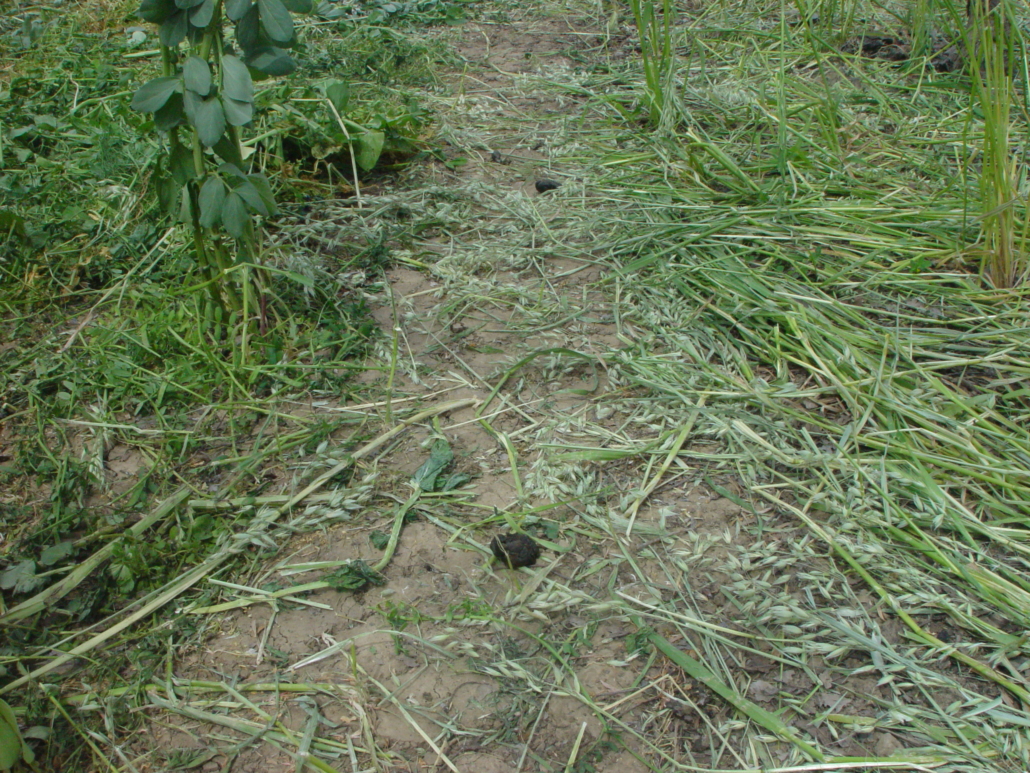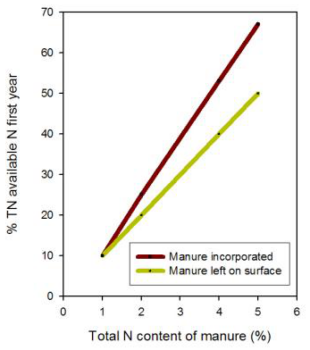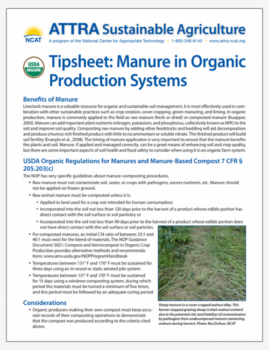Tipsheet: Manure in Organic Production Systems

Sheep manure in a cover cropped walnut alley. This farmer stopped grazing sheep in their walnut orchard due to the potential risk (and liability) of contamination by pathogens from undecomposed manure contacting walnuts during harvest. Photo: Rex Dufour, NCAT
By Thea Rittenhouse, NCAT Agriculture Specialist
Benefits of Manure
Livestock manure is a valuable resource for organic and sustainable soil management. It is most effectively used in combination with other sustainable practices such as crop rotation, cover cropping, green manuring, and liming. In organic production, manure is commonly applied to the field as raw manure (fresh or dried) or composted manure (Kuepper, 2003). Manure can add important plant nutrients (nitrogen, potassium, and phosphorus, collectively known as NPK) to the soil and improve soil quality. Composting raw manure by adding other feedstocks and bedding will aid decomposition and produce a humus-rich finished product with little to no ammonium or soluble nitrate. This finished product will build soil fertility (Evanylo et al., 2008). The timing of manure application is very important to ensure that the manure benefits the plants and soil. Manure, if applied and managed correctly, can be a great means of enhancing soil and crop quality, but there are some important aspects of soil health and food safety to consider when using it in an organic farm system.
USDA Organic Regulations for Manures and Manure-Based Compost 7 CFR § 205.203(c)
The NOP has very specific guidelines about manure-composting procedures.
- Raw manure must not contaminate soil, water, or crops with pathogens, excess nutrients, etc. Manure should not be applied on frozen ground.
- Raw animal manure must be composted unless it is:
Applied to land used for a crop not intended for human consumption; - Incorporated into the soil not less than 120 days prior to the harvest of a product whose edible portion has direct contact with the soil surface or soil particles; or
- Incorporated into the soil not less than 90 days prior to the harvest of a product whose edible portion does not have direct contact with the soil surface or soil particles.
- Raw animal manure must be composted unless it is:
- For composted manures, an initial C:N ratio of between 25:1 and 40:1 must exist for the blend of materials. The NOP Guidance Document 5021: Compost and Vermicompost in Organic Crop Production provides alternative methods and recommendations.
- Temperatures between 131° F and 170° F must be sustained for three days using an in-vessel or static aerated pile system.
- Temperatures between 131° F and 170° F must be sustained for 15 days using a windrow composting system, during which period the materials must be turned a minimum of five times, and this period must be followed by an adequate curing period.
Considerations
- Organic producers making their own compost must keep accurate records of their composting operations to demonstrate that the compost was produced according to the criteria cited above
- Sheep manure in a cover cropped walnut alley. This farmer stopped grazing sheep in their walnut orchard due to the potential risk (and liability) of contamination by pathogens from undecomposed manure contacting
- Compost that contains no animal materials as feedstock may be used without restriction provided that it contains no prohibited or restricted-use plant materials.
- If the composted manure is purchased, the grower needs documentation from the supplier showing that the compost process meets NOP requirements or else must undertake further composting on-site that meets NOP requirements.
- Manure left unincorporated for even a couple of days can lose a significant part of its nitrogen content through volatilization.
- Fresh manure can possibly transmit human disease (salmonella/E.coli), so fresh manure should not be used as a side-dress fertilizer on vegetable crops, and there are specific parameters on intervals between manure application and harvesting crops.
- Continual manure use tends to acidify soil. As manure breaks down, it releases various organic acids that assist in making soil minerals available. Over time, this process depletes the soil of calcium and causes pH levels to fall below the optimum for most crops. Manures do supply some calcium, but not enough to counterbalance the tendency toward increased acidity.
- Use of raw manures can sometimes increase weed problems. Some manure contains weed seed from bedding materials like straw and old hay. This problem can be eliminated if using composted manure.
- Fresh manure with high levels of nitrogen and salts can burn seedling roots. Manure should be tested before applying to soil.
- Heavy applications of raw manure can cause increased salinity in soils that do not drain well.
- Manure is rich in specific nutrients like phosphate and potash. These nutrients can benefit crops, but repeated applications can result in a detrimental buildup in the soil. Specifically, there has been a concern with an oversupply of phosphorus in soils where too much broiler litter or dairy manure is used. Excessive phosphate in the soil can interfere with plant uptake of other nutrients, such as copper and zinc. Excessive potash can restrict boron, manganese, and magnesium uptake (Kuepper, 2003).
NOP Recordkeeping Requirements
Accurate records of manure and compost application and production must be kept by all farmers using these types of soil amendments. Farmers must accurately record the application date of any untreated or composted soil amendment of animal origin. If the amendment came from a third-party source, documentation is required that the amendment has undergone a scientifically valid process to meet requirements for a treated amendment, and that it has been stored in a manner that prevents contamination of surrounding areas and water supplies.
NOP Manure Storage and Handling Requirements
- NOP requires farmers to handle and store biological soil amendments of animal origin in a way that does not contaminate covered produce; food-contact surfaces; areas used for growing, harvesting, holding, and packing; and water sources and distribution systems. Farmers must also make sure that treated amendments are not contaminated by untreated or “in-process” amendments.
- FDA does not allow the use of human waste for growing produce, except for sewage sludge bio-solids that are used according to Environmental Protection Agency requirements (FDA, 2015). Sewage sludge is prohibited
under the USDA organic regulations at section 205.105(g). - Manure can be stored if it is under the cover of a building or a tarp and away from any drainage areas and standing water.
Raw Manure vs. Composted Manure
- An effective composting process converts animal wastes, bedding, and other raw products into humus—the relatively stable, nutrient-rich, and chemically active organic fraction found in fertile soil. In stable humus, there is practically no free ammonia or soluble nitrate, but nitrogen is tied up as proteins, amino acids, and other biological components. Other nutrients are stabilized in compost as well (Kuepper 2003).
- Composting livestock manure reduces many of the drawbacks associated with raw manure use. It’s also less likely to cause nutrient imbalances. The composted manure can safely be applied directly to growing vegetable crops.
- Raw manure can be an excellent and effective source of available nitrogen and other nutrients, and can stimulate biological processes in the soil if the application is timed correctly, and if it is applied in the correct manner (refer to above considerations and NOP 5021 recommendations).
Manure Application and Rates
-

Figure 1. This graph predicts N release during the first year after manure application. Source: Adapted from Bary et al., 2000
Tilling manure into the soil shortly after spreading or applying it on cover crops are two safe application methods that conserve manure nutrients. Grass cover crops, such as rye and ryegrass, are especially good as “catch crops”—cover crops grown to absorb soluble nutrients from the soil profile to prevent them from leaching.
- Sheet composting, a process where a thin layer of slowly decomposing organic matter is applied on top of the soil and then tilled in, improves the capture of ammonia nitrogen from manure, but requires tillage, which leaves the soil bare and vulnerable to erosion and leaching losses. Surface application of manure (with no soil incorporation) eliminates most leaching and erosion losses but increases ammonia losses to the atmosphere.
- A combination of soil testing and nutrient budgeting for NPK levels is recommended when using manures, as nutrient levels can fluctuate based on many factors, and the timing of manure application is crucial to optimize nutrient uptake and minimize leaching. More information about nutrient budgeting can be found in ATTRA’s publication Nutrient Management Plan (590) for Organic Systems.
- The best time to apply manure, for the strongest effect, is just before planting. Applications too far in advance of planting risk nitrogen loss through leaching if rainfall is significant. Plowing or incorporating the manure into the soil is one method to use so that nutrient loss is minimal.
- It is important to monitor soil fertility regularly when using manure, to
avoid manure-induced soil imbalances as described above. - Typically, manure is applied before the most nitrogen-demanding crop in the rotation and after the amount of plant-available nitrogen during the year of application has been estimated. Nitrogen availability of manure varies greatly, depending on the type of animal, type and amount of bedding, and age and storage of manure. Manure should not be the sole nitrogen source in an organic system. Excess levels of soil phosphorus (P) can result from continual manure applications. Where P buildup is a concern, legumes should be included in the
rotation in place of manures to provide additional nitrogen (Eghball and
Power, 1999).
Food Safety Modernization Act (FSMA) Proposed Regulations for Manure Use
The Food Safety Modernization Act (FSMA) requires the Food and Drug Administration (FDA) to develop regulations aimed at improving the safety of produce. The process of developing these regulations is currently underway. It is good for producers to sign up for updates related to the new rules from organizations they trust. The FDA website contains up-to-date information about the proposed FSMA regulations.
New food-safety standards may address such topics as the following:
- Methods for preventing contamination of produce from exposure to pathogens potentially present in biological soil amendments of animal origin
- New standards for using manures and compost
Tipsheet: Manure in Organic Production Systems
By Thea Rittenhouse, NCAT Agriculture Specialist
Published July 2015
IP502
Slot 515
This publication is produced by the National Center for Appropriate Technology through the ATTRA Sustainable Agriculture program, under a cooperative agreement with USDA Rural Development. This publication was also made possible in part with support from U.S. Department of Agriculture’s Agricultural Marketing Service, National Organic Program.


